《1. Introduction 》
1. Introduction
China’s foreign dependence on oil is steadily increasing and far exceeds the international security warning threshold. Considering the unpredictable nature of the international economy and resource availability, China should achieve self-sufficiency in oil and gas [1–3]. The extensive unconventional oil and gas (e.g., shale and tight oil/gas and coalbed methane) reserves in China [4–7] contribute to more than 75% of the total national oil and gas reserves, and they are thus a vital alternative resource. However, the first drilling fluid that contacts unconventional oil and gas reservoirs can induce serious problems that subsequently affect drilling efficiency and production. For example, drilling fluid has been shown to alter the physical and chemical properties of reservoirs, impede oil and gas flow channels, reduce production, resulting in the loss of new oil and gas fields, and even destroy oil and gas layers [8–10]. Owing to the typically low permeability of unconventional oil and gas reservoirs, this frequently leads to borehole collapse, loss, and high friction, [11,12]; in addition to the development of bedding, nano-micro pores, and fractures [13], high cementation content, and severe reservoir variability and uncertainty. The reservoir borehole wall quality can also degrade, which allows a considerable amount of drilling fluid to enter the reservoir. In these cases, the depth and degree of reservoir damage can be worse than the damage inflicted on conventional oil and gas reservoirs. These compounded problems thus affect the production and benefit of oil and gas wells [14–19] and pose a major technical obstacle in the development of the petroleum industry.
The development of drilling fluid technology is key to addressing the aforementioned problems. In particular, water-based drilling fluids (WBDFs) show considerably brighter development prospects than oil-based drilling fluids (OBDFs). WBDF technology has passed through four stages since the 1960s: initiation, development, improvement, and the second round of development. The application of partially selective flocculants (e.g., hydrolyzed polyacrylamide) and its derivatives in the 1960s to the 1970s allowed drilling fluid systems to progressively develop from dispersible to non-dispersible polymer systems with low solid content [20], thereby improving the rate of penetration (ROP) and reducing the problems associated with complicated downhole conditions. However, few and inconsistent varieties of drilling fluid additives are available at this stage. From the 1970s to the 1980s, drilling fluid additives and technologies were rapidly developed, including trisulfonic drilling fluid systems comprising sulfonated phenolic resin, sulfonated lignite, sulfonated methyl tannin, or sulfonated asphalt. The 80A, PAC, SK series, and other drilling fluid additives were successively developed, and improved upon existing fluid temperature resistance and salinity tolerance parameters. The non-dispersible low-solid polymer drilling fluid technology was optimized, and drilling fluid systems capable of adapting to different areas and formation conditions were developed, noticeably improving jet drilling efficiency and speed [21]. Since the late 1980s, further efforts have been made to increase jet drilling efficiency, and cationic polymer NTW, zwitterionic polymer FA, and XY series additives have been developed. Cationic and amphoteric ion polymer drilling fluids have also been synthesized, the rheological parameters of drilling fluids have been optimized, and the temperature resistance of polymer drilling fluids has been further enhanced. However, the clay tolerance of the drilling fluid systems developed during this stage was insufficient and salt resistance was poor. Since the onset of the 21st century, exploration and developmental targets have shifted to more complex geological conditions, and the scaled application of horizontal wells and drilling fluid performance requirements have been broadened. This has led to the increased use of inhibited drilling fluid cuttings for the dispersion of fine cuttings, and the inhibition of borehole wall rock hydration, dispersion, and swelling; while simultaneously improving the wellbore stability. Therefore, a wide range of highperformance WBDFs with various characteristics have been developed. Low-invasion drilling fluids and film-forming WBDFs can prevent complex downhole situations or accidents, reduce drilling costs, be used to identify reservoirs, increase production, and are even good enough to be used in extreme conditions. Thus, the development of drilling fluid theory and technology has been extensively enhanced. However, problems regarding wellbore stability, lubricity, and reservoir protection effects persist, and the safe and efficient drilling requirements of long horizontal wells in complex formations continue to remain unsatisfied.
After more than 50 years of research, a series of formation protection drilling fluid technologies have been developed to reduce the formation damage attributed to drilling fluids. These approaches are mainly based on temporary plugging (e.g., shielding, fine physio-chemical films, and bionic) [22–39], and have improved formation protection measures in a stepwise manner. However, the basic principles of such protection technologies exploit the positive pressure differences between the drilling fluid column and formation pores to form a temporary plugging zone with extremely low permeability near the borehole wall. This prevents drilling fluids from later entering the reservoir; and thus, reducing the risk of reservoir damage. Perforation, dissolution, and flowback techniques are applied after well completion, to remove the temporary plugging zone and recover oil and gas flow, thus fulfilling formation protection objectives. However, such conventional approaches do not comprehensively consider the impact of borehole collapse, loss, and high friction, on formation damage. In particular, international frontier wellbore stability technology, which prevents collapse and fracture, mainly adopts chemical inhibition and plugging methods [40–42], which poorly inhibit the surface hydration of clays and cannot seal nano-micro pores and fractures nor improve the borehole wall rock strength and tightness via rock particle cementation. The damage associated with borehole collapse and loss are difficult to avoid. In unconventional oil and gas wells, priority is given to horizontal wells, and drilling operation times are long, further aggravating formation damage. Lubrication and torque reduction technologies presently play roles in altering the drilling fluid properties and flow behavior [43], but it remains difficult to form a smooth plane on the surface of the drilling tools and borehole walls. Moreover, high friction, large circulating pressure loss of the drilling fluid, and low jet drilling efficiency severely damage the reservoir and increase the duration of damage [44].
Environmental pollution is another important aspect of drilling efficiency and hinders the sustainable development of human society. Annually, more than 1 Mt of drilling fluid waste is produced by the oil and gas fields in China. Most of this waste is toxic, and its diffusion and migration cause long-term pollution over vast (>107 m2 ) areas of soil and water, as well as overall ecosystem degradation. Moreover, many unconventional oil and gas reservoirs in China are situated in picturesque (i.e., popular with tourists) and sensitive environments, in which strict external discharge requirements are imposed. The currently applied unconventional oil and gas drilling fluids do not satisfy environmental protection laws and standard requirements, and should not be directly discharged into the natural environment. Ecologicallyfriendly drilling fluids offer an improved direction for development. In terms of environmental protection considerations, ecologically friendly drilling fluids satisfy environmental protection performance requirements, and naturally degrade or decompose after being discharged into the environment; their byproducts can provide nutrients for animals and plants in the natural environment, thus serving as a beneficial link to ecological system cycles. However, very few studies have reported on the use of ecologically friendly drilling fluids.
In summary, although the current state-of-the-art WBDFs offer more environmental protection and cost advantages than OBDFs, they do not adequately minimize common formation damage issues (e.g., borehole collapse, loss, and high friction) that occur during the drilling of unconventional oil and gas wells. Internationally leading WBDF technology is presently unavailable in China, nor is it suitable for the complex formations encountered there. Furthermore, in terms of wellbore stability, although oil- or synthetic-based drilling fluids have more specific advantages than WBDFs lubrication, and formation protection, their applications are generally restricted; owing to high costs and increasingly high pressures to ensure environmental protection [45,46]. Accordingly, the research carried out over the last decade has focused on how the advantages of OBDFs and WBDFs can be incorporated to improve WBDF performance [47–49]. However, no substantive progress has been made, an outcome that has limited the realization of the goal to strategically replace alternative resources, including the safe, efficient, economic, and environmentallyfriendly drilling of unconventional oil and gas. Thus, this issue has become a key and core technical problem.
To address these technical problems, this study introduces bionics [50] to the field of petroleum engineering, to imitate the structure, function, and principle of marine mussels, pitcher plants, and earthworms. A borehole strengthening agent, amphiphobic inhibitor, and bonding lubricant were systematically studied and developed; which can improve wellbore quality. A new WBDF technology was developed to protect formation integrity using these three additives while simultaneously considering both internal and external factors. This method aims to eliminate the risks of damage associated with borehole collapse, loss, and friction, while upgrading the drilling fluid classification from environmentally protective drilling fluid to an ecologically friendly drilling fluid. The specialized effects are demonstrated by the application of the three novel drilling fluid materials, which are shown to improve the strength and compactness of the rock near the borehole walls, modify wettability, and improve surface lubricity. The additive mechanisms were also investigated. A comprehensive performance assessment and mechanistic study are conducted on the newly developed WBDFs, and the application effects exerted by the drilling fluid technology in unconventional oil and gas reservoirs are discussed. This marks the formation of a novel WBDF technology that is ecological, protects the formation integrity, improves borehole wall quality, and provides key and core engineering and technical support for the realization of the goal to simultaneously obtain high well completion ratios, good formation protection effects, low costs, and environmental friendliness.
《2. Materials and methods 》
2. Materials and methods
《2.1. Experimental materials》
2.1. Experimental materials
The borehole wall quality is mainly characterized by rock strength, compactness, and lubricity. These properties not only affect underground safety conditions, but also strongly influence the risk and extent of borehole collapse, loss, and friction damage. Three novel drilling fluid materials were developed to address the technical problem of severe borehole quality damage during the drilling of unconventional oil and gas reserves.
Marine organisms such as mussels adsorb rocks by secreting highly adhesive and water-resistant adhesive proteins. L-dopa and hydrophobic groups are the main components of adhesive proteins and provide mussels with strong adhesion and cohesion properties via conformational variations, chain cross-linking, electrostatic interactions, hydrogen bonding, and hydrophobic interactions with the substrate [51–53]. Drilling fluids are often applied in complex underground environments with high temperatures and pressures; thus, the proposed method adopts multiple attributes, diverse affinities, and the chemical versatility of the catechol functional groups of L-dopa. The stem grafting method is applied to synthesize WBDF additives (i.e., borehole strengthening additive) with similar compositions and functions as mussel foot proteins [39,54,55].
The area around the mouth of common nepenthes has amphiphobic wetting characteristics, in which oil/water droplets run around the surface rather than wet it. Existing studies [56] have shown that the superamphiphobic nature of the area around the mouth of common nepenthes is attributable to the joint effects exerted by the chemical composition of reticular wax and the surface morphology of the nanoscale lamellar structure, as well as micron-scale crescent composite structures. Based on the amphiphobic mechanism of the rough nano-micro multistage physical structure and super-low surface free energy [57], nano silicon dioxide (100 nm), and carbon nanotubes (5 nm diameter, 1– 2 μm length) were selected as the constituents for a multi-scale nano-micro rough physical structure. Additionally, the surface free energy was further reduced by surface modification. A WBDF additive (an amphiphobic inhibitor) was synthesized for the design of the wettability of the borehole wall and drilling tool surface to have superhydrophobic properties [31,58–60].
The mucus secreted by earthworms makes the surface of their body hydrophobic, alters the soil surface energy and composition, reduces the resistance from friction, and enables them to travel freely in soil [61]. Inspired by this design, the stem grafting method was adopted to introduce multi-point adhesive groups into longchain molecules, and a polyester WBDF additive and bonded lubricant were developed to increase the adsorption properties of the surface of the drilling tools and borehole walls [62,63].
Other materials were used to compare the effects of the three additives described above and prepare the drilling fluids, all of which were obtained from Beijing Shida Bocheng Technology Co., Ltd., China.
《2.2. Additives and drilling fluid performance evaluation methods 》
2.2. Additives and drilling fluid performance evaluation methods
2.2.1. Borehole strengthening additive
Core triaxial strength tests were performed according to standard DZ/T 0276.20–2015 [64] and a TAR-1500 triaxial strength test device (Changchun Huiyang Company, China) was used to analyze the cores treated with different additives. X-ray diffraction (XRD) analysis was performed according to standard SY/T5163-2010 [65] using a D8 Advance diffractometer (Bruker, Germany). A beam wavelength of 0.15406 nm was used to analyze the interlayer spacing of bentonite in various dry samples, with a 2θ scanning angle of 2°–10°. An Escalab 250 X-ray spectrometer was used to perform elemental analysis of the sample surface via X-ray photoelectron spectroscopy (XPS). Prior to testing, the samples were pressed for 30 s at 10 MPa. Micromorphology analysis was performed using a Hitachi SU8010 scanning electron microscope (Japan) to characterize the surface morphology variations of shale cuttings before and after treatment.
2.2.2. Amphiphobic inhibitor
Contact angle tests were performed using a contact angle measuring instrument (JC2000D3, China), to examine the contact angle of the liquid on the substrate surface. Cutting rolling recovery tests were performed on 20.0 g of shale cuttings. The cuttings were screened from the particles sifted through meshes sized 6 to 10, and placed into 350 mL of drilling fluid at specific temperatures to age for 16 h. The residual proportion of cuttings was then determined using a screen of mesh size 40. Linear expansion tests were performed on 5.0 g of bentonite pressed into a core at 10 MPa for 5 min. The linear swelling height impacted by the different treatment agents was analyzed using a CPZ-II dual-channel linear expansion meter (Tongchun, China). Atomic force microscopy (AFM) was performed using a JPK atomic force microscope (Bruker, USA) to characterize the surface morphology of the silicon wafer. The core self-absorption method and capillary pressure calculation pressure are described in Ref. [66].
2.2.3. Bonding lubricant
Extreme-pressure lubrication tests were performed on the 4% base slurry that had 1% of the individual lubricants added to it. A FANN 212 extreme-pressure lubrication meter (Fann Instrument Company, USA) was used to determine the extreme pressure coefficients of the different systems. Four-ball friction tests were performed to measure the lubrication effect of the different samples using MS-10A four-ball friction test machine (Xiamen Tianji Automation Co., Ltd., China), at a load of 150 N, speed of 150 r·min–1 , and friction applied over 20 min. The scratches on the surfaces of the steel balls were subsequently examined.
2.2.4. Drilling fluid system
The performance of the drilling fluid system (e.g., rheology, filtration loss, inhibition, and filter cake friction coefficient) was assessed in accordance with the standard GB/T 16783.1–2014 [67]. Compressive strength tests were performed on cuttings with similar performances that were crushed, pressed into cores, and then placed into aging cans that contained different drilling fluids. The cores were aged for 3 and 10 d under specific temperature conditions and then removed. A WDW-100Y strength tester (Jingzhou Modern Petroleum Science and Technology Co., Ltd., China) was used to determine the compressive strength of the samples. The formation protection effect was assessed using a JHMD-II high-temperature and highpressure core dynamic damage assessment system (Jingzhou Modern Petroleum Science and Technology Development Co., Ltd.) by performing a dynamic pollution experiment on the core edge. A NanoVoxel-3000 series high-resolution X-ray three dimensional (3D) microscope (Tianjin Sanying Precision Instrument Co., Ltd., China) was used to examine 3D images of the core before and after contamination, according to the SY/T 7410.1–2018 standard [68]. Variations in the microscopic porosity and permeability of the core were investigated. Analysis of the lubricant adsorption film thickness was performed based on the four-ball friction experiments on different drilling fluid systems. Argon ion thinning (20 nm·time–1 ) was performed five times on the steel ball surface after the experiment, and the surface contents of iron (Fe2p3) and carbon (C1s) were determined using XPS to analyze the adsorption film thickness. An environmental protection assessment was performed on the drilling fluid in terms of biological toxicity (luminescent bacteria method), degradability (biochemical oxygen demand (BOD)/chemical oxygen demand (COD) ratio method), and heavy metal content. The ecological assessment was conducted using wheat seed plant cultivation (rhizome elements, aflatoxin, and chlorophyll content tests), as described in detail in ref [69].
《3. Experimental results and discussion 》
3. Experimental results and discussion
《3.1. Construction of technology to improve reservoir borehole wall quality》
3.1. Construction of technology to improve reservoir borehole wall quality
3.1.1. Improvements in rock strength and tightness near the borehole wall
As the drilling fluid filtrate enters the rock holes and fractures, the mechanical properties (e.g., compressive strength, elastic modulus, and cohesion) of borehole wall rocks treated with drilling fluid are generally reduced due to hydraulic splitting, thus weakening the overall rock structure because of water absorption and the expansion of clay minerals in the cement [70]. Shale cores with similar initial mechanical properties were selected and soaked in fresh water, 3% borehole strengthening additive, and 10% KCl solution for 48 h at room temperature. The variations in their mechanical parameters were investigated, and the results are listed in Table 1. The compressive strength and elastic modulus of the treated core decreased in all solutions, compared with those of the untreated core under confining pressures of 0, 10, and 20 MPa. Taking the 20 MPa confining pressure test as an example, the compressive strength of the core decreased by 18.62% after soaking in freshwater, 14.39% after soaking in 3.00% borehole strengthening additive solution, and 9.00% after soaking in 10% KCl solution. The cohesion, which reflects the attraction between adjacent mineral particles in a rock, was calculated according to the MohrCoulomb criterion (Mohr’s circle). The results indicate that the core cohesion values decreased by 42.10%, 72.56%, and 54.46%, after soaking in the borehole strengthening additive solution, freshwater, and 10% KCl solution, respectively. The data show that the compressive strength retention effect of the 0.3% borehole strengthening additive solution was similar to that of the 10% KCl solution; however, the former better maintained the level of cohesion. This indicates that the borehole strengthening additive can effectively minimize reductions in rock strength and maintain borehole wall stability.
《Table 1》
Table 1 Mechanical properties of the shale cores soaked in different solutions.

A considerable number of adsorption groups exist on the molecular chain of the borehole strengthening additive, which may have a strong adsorption effect on the rock. The high clay mineral content in mud shale leads to the hydration of expandable minerals (e.g., montmorillonite) and poor cementation between particles, thereby resulting in rock fracturing and a reduction in the borehole wall stability. The XRD patterns of dry bentonite (Fig. 1(a)) showed an increase in the interlayer spacing d(001) from 1.195 to 1.345 nm after being soaked in the borehole strengthening agent. This demonstrates that borehole strengthening additive molecules inserted and were adsorbed between the clay crystal layers, preventing the entry of water molecules. The XPS analysis (Fig. 1(b)) shows that bentonite initially contained 58.52% oxygen, 18.90% silicon, 13.85% carbon, 6.82% aluminum, and 1.91% magnesium (in atomic percent). The silicon, aluminum, and oxygen contents in bentonite decreased after being treated with the borehole strengthening additive, whereas the carbon content increased. This indicates that borehole strengthening additive molecules were effectively adsorbed on the surface or between the crystal layers of bentonite, thus providing a protective coating (Fig. 1(c)). This multi-level adsorption can enhance the hydrophobicity of bentonite particles, thus inhibiting hydration and avoiding the shale borehole wall. Fig. 2 shows the surface morphology of the shale cuttings before and after they were soaked in the borehole strengthening additive solution. The cutting surface showed numerous fractures prior to treatment, whereas the treated surfaces were smooth and compact. Thus, further cracking was avoided.
《Fig. 1》
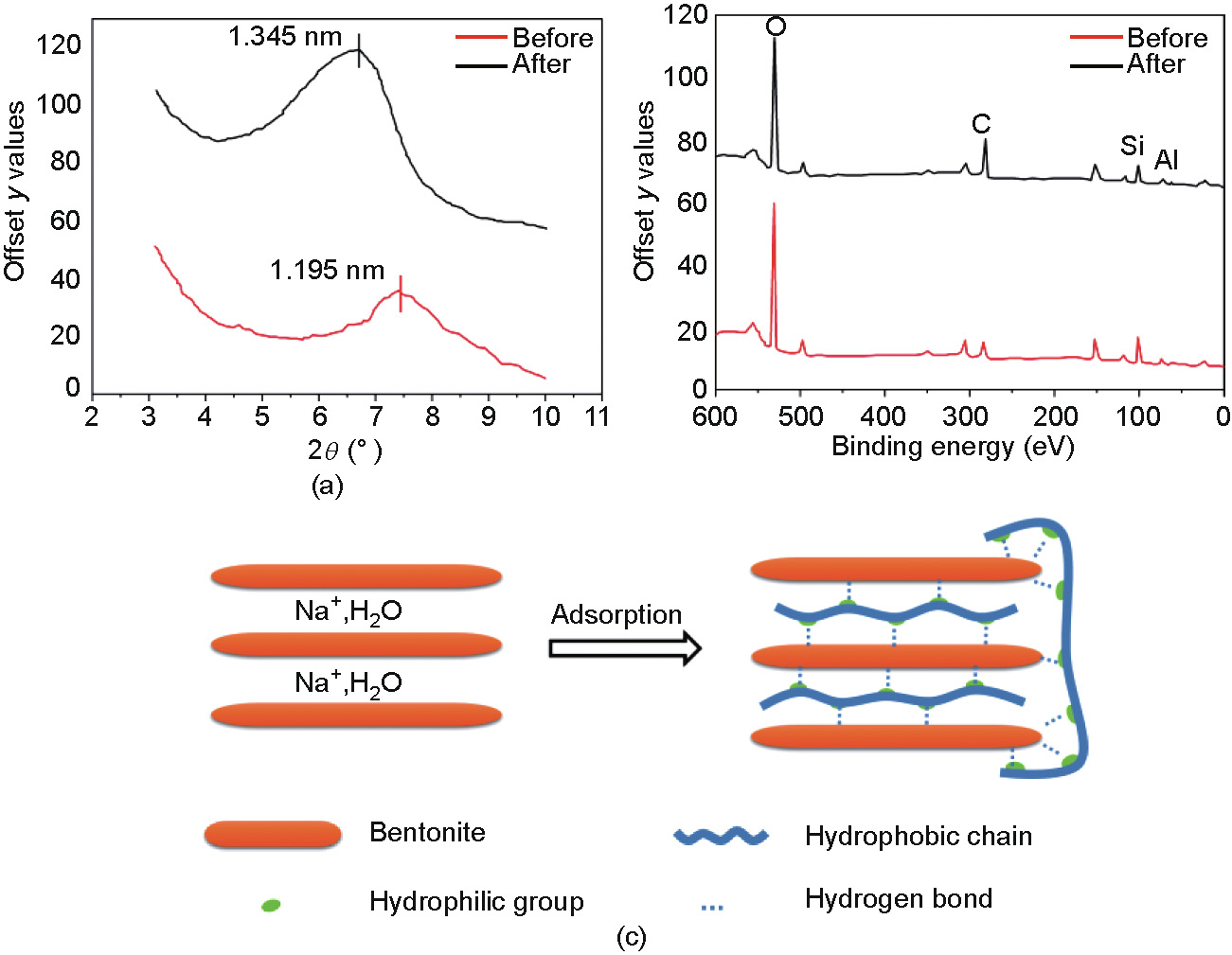
Fig. 1. Mechanism of the borehole strengthening additive: (a) variations in bentonite interlayer spacing; (b) variations in surface element content in bentonite; (c) schematic illustration of the adsorption state of the borehole strengthening additive in bentonite.
《Fig. 2》

Fig. 2. Surface morphology of shale cuttings (a) before and (b) after treatment with the borehole strengthening additive.
Borehole strengthening additives can inhibit the hydration of clay minerals and form a microbiological mesh gel directly on the surface and between particles, to maintain the integrity of the borehole wall rock Fig. 3. Figs. 3(b) and (c) show the morphology of a pressed core of the non-expandable clay mineral illite soaked in a strong inhibition solution (7% KCl + 2% polyether amine (PEA)) and 3% borehole strengthening additive solution, respectively, for 24 h. The core disintegrated after soaking in the former, whereas the sample remained intact after soaking in the latter. The results indicate that the borehole strengthening additive can keep the core intact by improving the cohesion between particles.
《Fig. 3》

Fig. 3. The appearance of illite core soaked in strong inhibition solutions: (a) initial illite core; (b) core appearance after soaking in 7% KCl + 2% PEA solution for 24 h; (c) core appearances after soaking in 3% borehole strengthening solution for 24 h.
Conventional borehole stability measures mainly include inhibition (i.e., osmotic hydration) and plugging methods, which only prevent or reduce the borehole wall damage caused by drilling fluids, but cannot improve the rock cohesion strength or rock cementation forces. Thus, these methods fail to fundamentally resolve the borehole instability problem. Borehole strengthening additives can synergistically improve the cohesion between rock particles by forming a microbiological mesh gel on the rock surface with multiple levels of adsorption, to essentially inhibit shale hydration by cementing the borehole wall.
3.1.2. Improvements in the wettability of the rock near the borehole wall and reverse capillary pressure
The wettability of the borehole rock surface plays a vital role in borehole stability. Natural rocks contain a considerable number of capillary pores and micro-fissures. When the rock surface is hydrophilic and lipophilic, the capillary self-imbibition effect drives a large amount of water and oil (or lipophilic substances) to enter the rock, thereby causing wellbore instability and formation damage (e.g., water locking or emulsion blocking). The AFM test (Fig. 4) shows that amphiphobic inhibitors can inhibit wettability by adsorbing and constructing rough nano-micro structures on the rock surface and reducing surface free energy. The surface of the silicon wafer before and after treatment showed the formation of multiple rough physical structures, and the peak height increased from 2.0 to 34 nm. This rough, multi-scale, nano-micro structure is critical for altering the wettability of the core surface.
《Fig. 4》
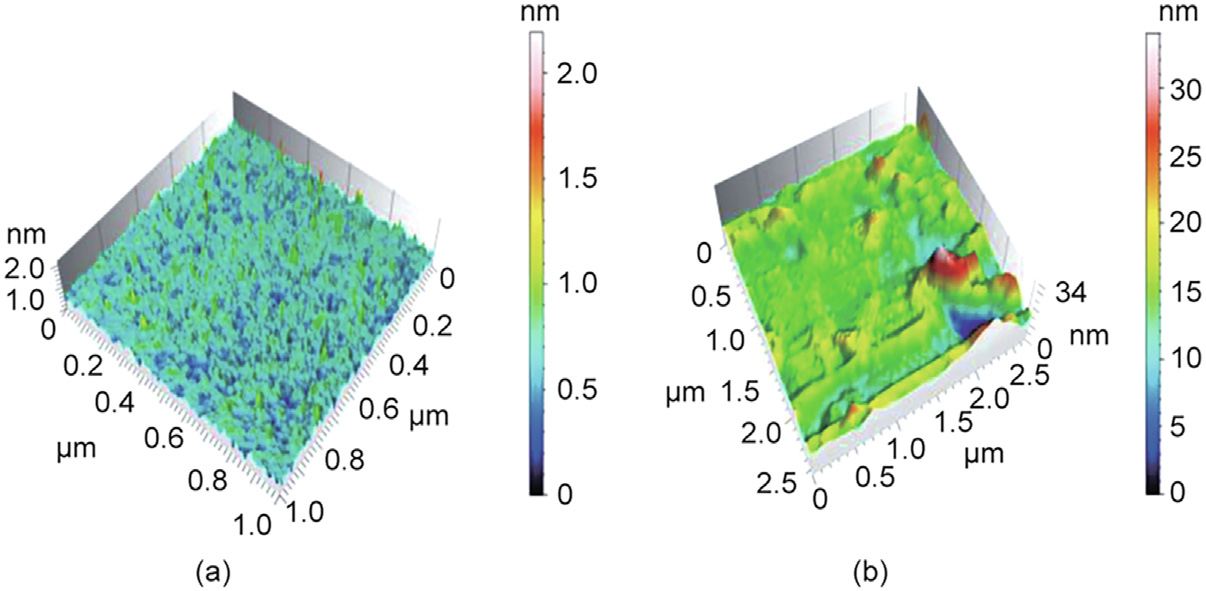
Fig. 4. Variations in silicon wafer surface morphology (a) before and (b) after amphiphobic inhibitor treatment.
Fig. 5 shows the contact angle variations of the oil phase (nhexadecane) and water phase (deionized water) on the core surface before and after amphiphobic inhibitor treatment. The oil and water phases on the core surface tended to increase with increasing amphiphobic inhibitor concentrations, and the twophase contact angle stabilized when the amphiphobic inhibitor concentration reach 3%; the oil-contact contact angle increased from 0° to 125°, and the water-contact contact angle increased from 36° to 155°.
《Fig. 5》
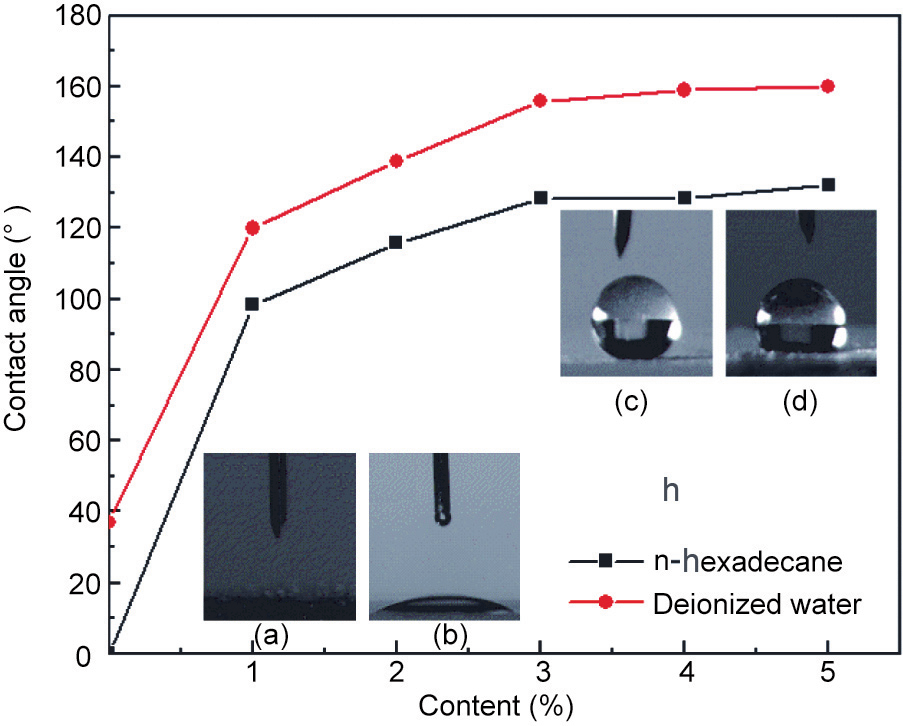
Fig. 5. Contact angle of oil and water phases on the core surface as a function of amphiphobic inhibitor dosages. (a) Water phase and (b) oil phase droplet states with 0% amphiphobic inhibitor; (c) water and (d) oil phase droplet states with 3% amphiphobic inhibitor.
The results of the core self-imbibition experiments (Table 2 and Table 3) show that the core water absorption decreased significantly from 8.76 to 0.03 mL after treatment with the amphiphobic inhibitors; a reduction of 99.66%. On the other hand, the other additives (e.g., KCl) exerted considerably smaller reduction effects (7.31%–10.16%). When the mean pore size of the core increased from 50 to 250 nm, the self-imbibition amount of the core treated with the amphiphobic inhibitor slightly increased from 0.03 to 0.62 mL and maintained a relatively high reduction range (92.41%–99.66%). Moreover, the contact angle of the core surface changed to 155.72° after 3% amphiphobic inhibitor treatment, and the capillary pressure was reversed, to –833.98 kPa (the negative sign represents the reversed direction of the capillary pressure). In contrast, after treatment with other common additives such as dimethyl diallyl ammonium chloride (DMDAAC), the contact angle ranged between 11° and 28°, and the capillary pressure ranged from +789 to +818 kPa. This was largely because the amphiphobic inhibitor formed a nano-micro structured layer on the pore surface of the core, thereby altering its wettability and transforming the core surface from hydrophilic/oleophilic to hydrophobic/oleophobic. The direction of capillary pressure was also reversed within the core, which eliminated core-water contact.
《Table 2 》
Table 2 Variations of the self-imbibition water absorption, contact angle, and capillary pressure of the cores with an average diameter of 50 nm treated by different additives.

Note: The negative sign represents the reversed direction of capillary pressure. The capillary pressure before treatment was 880.73 kPa and the surface tension of the water phase was 72.80 mn·m–1 . EPTAC: epoxypropyl trimethyl ammonium chloride.
《Table 3》
Table 3 Self-infiltration water absorption of the cores with different pore sizes before and after amphiphobic inhibitors treatment.

Compared to the other common inhibitors, the amphiphobic inhibitors also exhibited optimal inhibition (Table 4). The XRD results show that the intergranular spacing of the bentonite particles treated with 3% amphiphobic inhibitor decreased from 1.985 to a minimum of 1.386 nm after the treatment, which demonstrates that the expansion of clay particles was significantly inhibited. Moreover, the linear expansion height of the bentonite core with the 3% amphiphobic inhibitor treatment was only 1.59 mm, the rolling recovery rate of the shale cuttings reached their highest value (78.79%), and the ability to inhibit clay hydration and expansion was relatively strong (Fig. 6).
《Table 4》
Table 4 Interlayer spacing testing of bentonite clay

《Fig. 6》

Fig. 6. Results of the inhibition assessment of the amphiphobic inhibitors: (a) linear expansion height; (b) rolling recovery rate.
In conclusion, compared with conventional drilling fluid inhibitors, amphiphobic inhibitors can alter the core surface wettability and reverse the direction of capillary pressure by building rough multi-scale physical structures on the surface. This directly avoids contact between borehole rocks, especially between clay minerals and free water, and thus promotes borehole stability.
3.1.3. Improvements in the rock surface lubricity of the reservoir borehole wall
Horizontal wells with long horizontal laterals can increase the oil and gas drainage area and enhance production and have thus become the mainstream well type for the exploration and development of unconventional oil and gas resources. However, long horizontal sections can lead to high friction and high torque, reduce drilling speed, increase the contact time between the drilling fluid and reservoir, and aggravate formation damage. Lubrication is an effective measure that facilitates increases in drilling speed and reduces formation damage. Table 5 compares the lubrication effects exerted by bonding lubricants and other common lubricants in a 4% bentonite-based slurry. The experimental results indicate that upon the addition of a bonding lubricant, the extremepressure friction coefficient decreased by 83.3%, compared with the blank base slurry; whereas the reduction rate of the other common lubricants ranged between 40.7% and 81.5%. The lubrication effect of the bonding lubricant did not decrease after aging at 150 °C for 16 h, but further increased instead. The extremepressure friction coefficient decreased by 90.4% after treatment with the bonding lubricant, whereas the other common lubricants led to reductions of 38.5%–84.6%.
《Table 5 》
Table 5 Extreme-pressure lubrication test results of different lubricants in 4% bentonite base slurry.

Four-ball friction experiments were performed to further study the lubrication effects of the bonding lubricant on the metal. Fig. 7 shows the scratches on the steel balls that formed during the fourball friction tests. The results show that the scratches in the freshwater tests were visible and contained deep furrows, and the spot area was the largest. After the addition of the lubricant, the spot diameter decreased. For example, the friction marks were least noticeable and the friction surface was the smoothest after the bonding lubricant treatment. In contrast, scratches were observed after the addition of other lubricants. This indicates that the addition of bonding lubricant to 4% base slurry can be used to construct a long-term lubrication layer and significantly reduce the lubrication coefficient of the base slurry, thus complying with the extreme-pressure friction coefficient measurement results. This is mainly because the conventional lubricant plays a role by altering the nature of the drilling fluid and flow behavior. In contrast, the smoothness produced by the surface bonding lubricant depended on combinations of the active component and lubricant within the hole ions and on the drilling tools and borehole wall surface (iron ions were detected on the drilling tool, and silicon ions and aluminum ions were detected on the formation). This effectively controlled the inherent vortex in the flow interface and reduced the friction between the drilling fluid on the rock surface and drilling tools.
《Fig. 7》
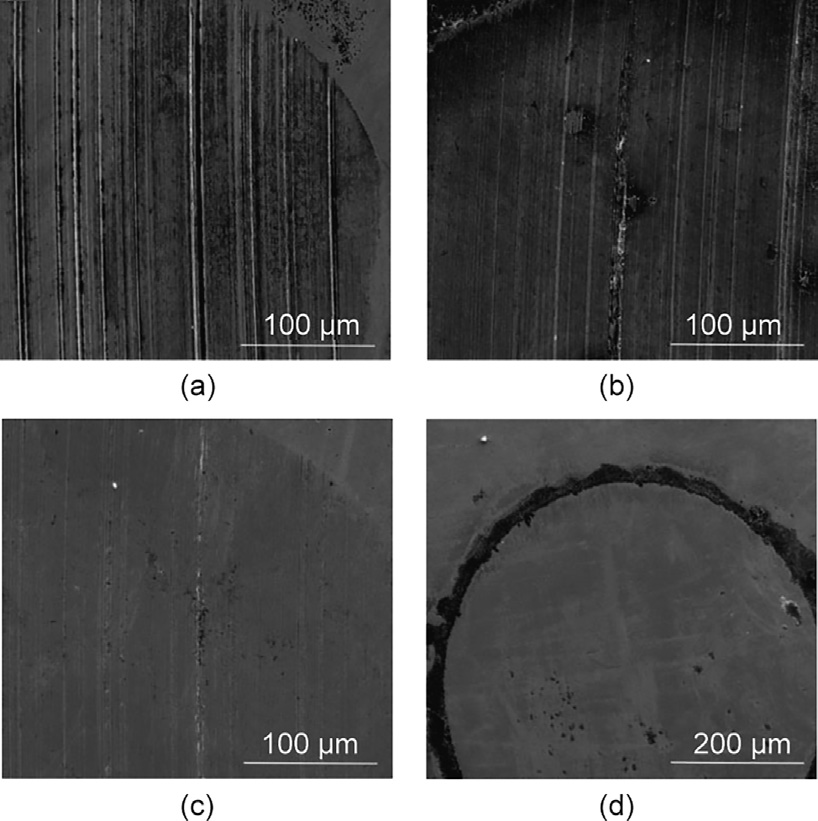
Fig. 7. Comparison of the scratches after treatment with different lubricants in the four-ball friction experiments. (a) Fresh water; (b) domestic advanced lubricant (PF-Lube); (c) foreign advanced lubricant (DEF-Eastman company, USA); (d) bonding lubricant.
《3.2. Establishment and performance assessment of WBDF for the improvement of wellbore quality during drilling and protection of formation integrity》
3.2. Establishment and performance assessment of WBDF for the improvement of wellbore quality during drilling and protection of formation integrity
A WBDF was invented to improve the borehole wall quality while drilling and to protect the reservoir using a borehole strengthening additive, amphiphobic inhibitor, and bonding lubricant as the core additives, with the necessary support of fluid loss reducer. The basic formulation of the drilling fluid was 0.15% bentonite slurry, 2%–3% borehole strengthening additive, 1%–2% bonding lubricant 2%–3% amphiphobic inhibitor, 0.5%–1.0% flow type lubricant, 1%–3% fluid loss reducer, 7% KCl, 1%–3% rheological regulator, and barite (adjusted to the required density). The performance of the WBDF was compared with that of a typical OBDF comprising 282 mL white oil, 3% MOGEL, 3% primary emulsion, 3% auxiliary emulsion, 5% MOLSF, 5% MORLF, 5% MOALK, 18 mL 25% CaCl2 brine, and barite (adjusted to the required density).
3.2.1. Rheology, filtration, and lubrication
The results indicate that the developed WBDF has a higher yield/plastic viscosity ratio, better rheological properties, similar filtration (under both API conditions (filtration) and high-temperature high-pressure conditions (HTHP filtration)), lower filter cake viscosity coefficient, and better lubrication than the typical OBDF (Table 6).
《Table 6》
Table 6 Rheological properties and filtration of drilling fluid systems.

3.2.2. Inhibition
Rock cuttings were collected from shale gas wells in the Weiyuan area of China, which is prone to borehole collapse, and used for rolling recovery experiments. When rolling at 150 °C for 16 h, the primary and secondary recovery rates of the developed WBDF were higher than those of the typical OBDF and other existing high-performance WBDFs (Table 7).
《Table 7》
Table 7 Comparison of rock cutting recovery rates (aging temperature: 150 °C, aging time: 16 h).

3.2.3. Core strength
Table 8 compares the compressive strengths of the cores soaked in various drilling fluid systems. The results indicate that the compressive strength of the core immersed in the developed WBDF for 3 d increased by 4.22% and 59.35% over that of the typical OBDF and other high-performance WBDFs, respectively, and by 18.26% and 286.57% after 10 d of immersion. The range of improvement increased with time, and the developed WBDF thus achieved the objective of improving the core strength.
《Table 8》
Table 8 Comparison of compressive strength of the cores after soaking in various drilling fluid systems (soaking temperature: 120 °C, pressure: 3.5 MPa).

The original core strength was 8.89 MPa, which decreased to 1.82 MPa after soaking in water for 3 min.
In conclusion, the microscopic biological mesh gel of the borehole strengthening additive on the core surface and multipoint absorption improved, and the bonding force and cohesion between rock particles effectively prevented surface hydration and hydration penetration. Coupled with the amphiphobic inhibitors, the wettability of the core surface was reversed, to overcome the capillary effect issue, thus better stabilizing the borehole wall than a typical OBDF. The key technical problem of borehole instability during the drilling of long horizontal wells in unconventional oil and gas reservoirs has therefore been solved.
3.2.4. Reservoir protection
Core end-face contamination experiments were performed using the developed WBDF and typical OBDF, yielding core permeability recovery values as high as 96.5% and 94.4%, respectively (Table 9). Computer tomography was used to image the cores before and after contamination, and the spatial parameter variations in core porosity and permeability were investigated (Fig. 8, Table 10). The results indicate that the porosity and permeability within the core decreased after the contamination of the two drilling fluids. However, the reduction amplitude of the storage and permeable space along the z-axis after WBDF contamination was lower than that of the typical OBDF. This demonstrates that after formation damage, the permeable space narrowed and connectivity decreased. Compared to the typical OBDF, the developed WBDF promoted the range of permeability reduction and downregulated the degree of damage. This demonstrates that the formation protection effects of the developed WBDF are better than those of the typical OBDF.
《Table 9》
Table 9 Comparison of core permeability recovery values in various drilling fluid systems (contamination temperature: 120 °C, pressure: 3.5 MPa).

《Fig. 8》
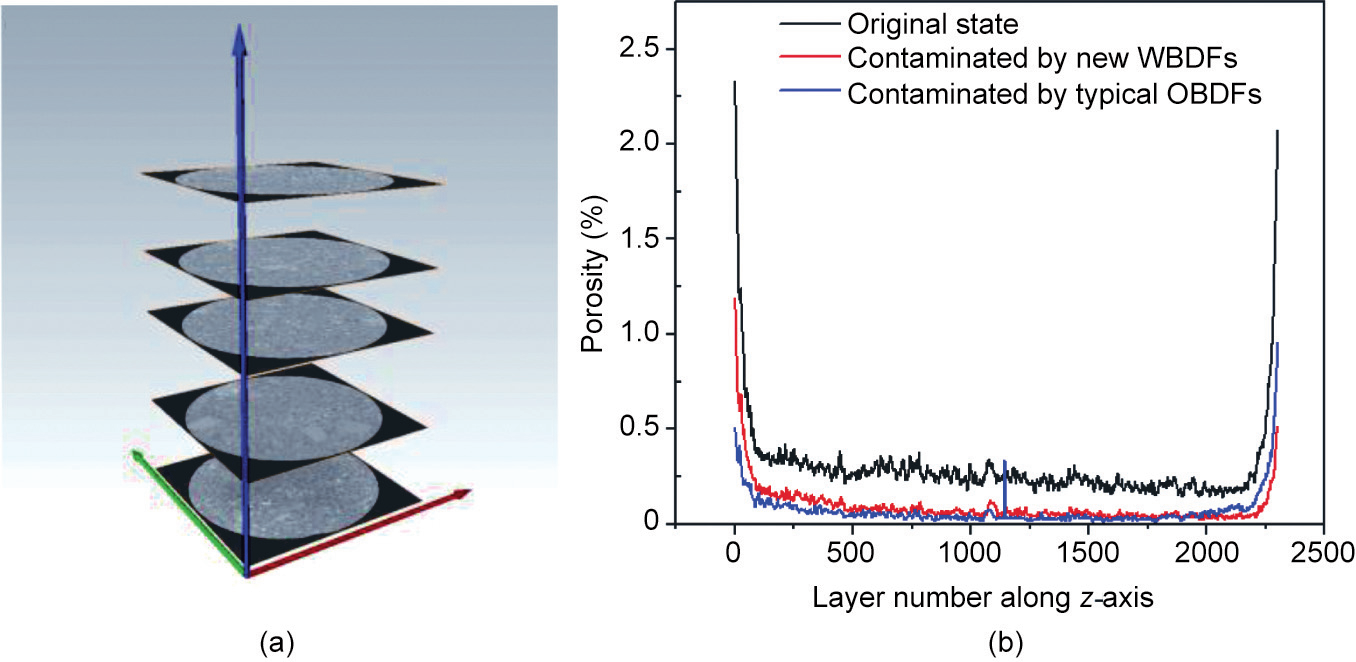
Fig. 8. Variations in the porosity of the core along the z-axis: (a) core sections along the z-axis; (b) porosity variation.
《Table 10》
Table 10 Comparison of the space parameters before and after core contamination.

3.2.5. Lubricity
The lubricating effects exerted by other high-performance WBDFs (taken from the Weizhou Oilfield in Nanhai, China) before and after the addition of 2% bonding lubricant were examined by performing extreme-pressure lubrication tests and four-ball friction tests (e.g., adsorption film thickness analysis). Table 11 lists the extreme-pressure lubrication test results for the different systems. The friction coefficient of other high-performance WBDFs was 0.19, which was 44.1% lower than that of freshwater. After the addition of the bonding lubricant, the friction coefficient was only 0.10, which was 70.6% lower than that of freshwater. The surface morphology of the steel balls after the four-ball friction test revealed that the WBDF bonding lubricant produced smaller friction spots (Φ = 527.12 μm) and a smooth surface, whereas those corresponding to the original WBDF had larger friction spots (Φ < 720.72 μm) and a rough surface, as shown in Fig. 9. The generally lower friction coefficient and smaller ball spot size that resulted from the addition of the bonded lubricant to the WBDF effectively and beneficially absorbed a lubricating film layer, thus reducing the friction and wear on the steel ball. The thickness of the adsorption film was determined by further examining the depth of the iron and carbon contents on the steel ball surface, as illustrated in Fig. 10. The iron and carbon contents on the surface of the steel ball tested in the WBDF system without bonding lubricant significantly increased with increasing thinning time (scanning depth of 0–100 nm). This demonstrates that the thickness of the adsorption film on the surface of the steel ball was less than 20 nm. In contrast, the iron content on the surface of the steel ball tested in the WBDF system with bonding lubricant was essentially zero and remained constant with increasing thinning times, whereas the carbon content was high and varied insignificantly. This demonstrates that the thickness of the adsorption film on the surface of the steel ball was greater than or equal to 100 nm. In summary, the bonding lubricant effectively adsorbed onto the surface of the metal drilling tool in the drilling fluid to form a thick and strong lubrication film, which improved the lubricating effect of the drilling fluid and enabled an increase in the drilling speed.
《Table 11》
Table 11 Extreme-pressure lubrication test results for different samples.

《Fig. 9》
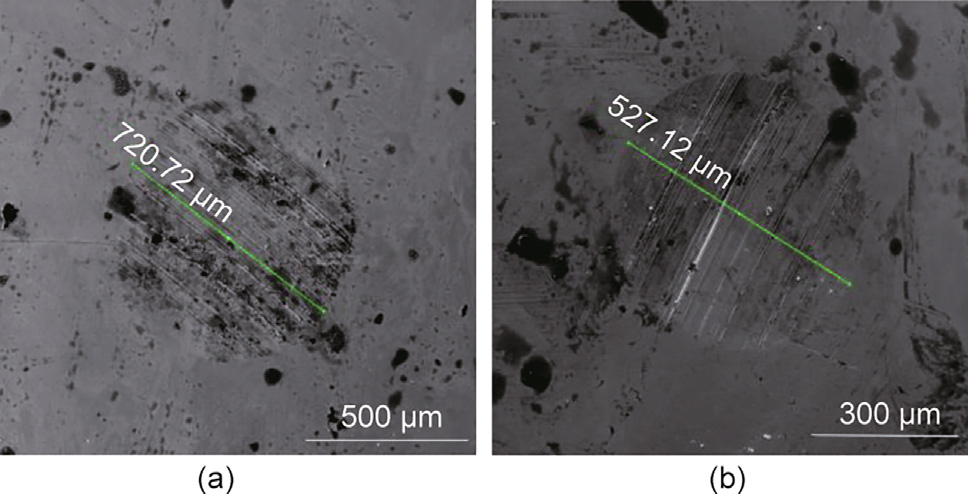
Fig. 9. Size of the ball spots before and after the addition of bonding lubricant to the drilling fluid system: (a) without bonding lubricant; (b) with 2% bonding lubricant.
《Fig. 10》

Fig. 10. Variations in the element content of the steel ball surface with different thicknesses (0–100 nm) before and after the addition of bonding lubricant to the drilling fluid system: (a) iron; (b) carbon.
3.2.6. Environmental protection and ecology assessment
The biotoxicity test results of the developed WBDF were as follows: concentration for 50% of maximal effect (EC50), 50 000 mg·L–1 ; BOD, 14 100 mg·L–1 ; and COD, 26 600 mg·L–1 . The BOD/COD ratio was 53.00%. The developed WBDF is non-toxic, easily degradable, and does not contain heavy metals, which meets environmentally friendly requirements. For further confirmation, 420 wheat seeds were planted in natural soil (No. I), conventional polymer drilling fluid (No. II), the developed WBDF (No. III), and the developed WBDF solution which had been diluted by a factor of two (No. IV). The seeds were cultivated under the same conditions, and their growth was observed. Table 12 and Fig. 11 present the germination rates of the wheat seeds cultivated in the various drilling fluid systems, as well as the observations of their growth after various lengths of cultivation. The results indicated that the germination rate of the wheat seeds cultivated in liquid No. I reached 96.90%, and the environmental protection performance of the drilling fluid was better than that of liquid No. II. However, the wheat germination rate (60.48%) and growth conditions in liquid No. III were still affected to some extent. In contrast, liquid No. IV had no impacts on wheat growth, yielding a germination rate of 93.06%, and plant growth was vigorous and healthy (Fig. 12).
《Table 12》
Table 12 Germination rate of wheat seeds cultured in various drilling fluid systems.
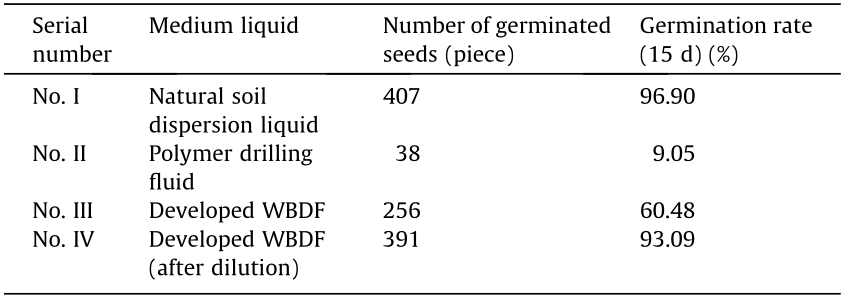
No. I: fresh water + 65.5% natural soil; No. II: fresh water + 2% bentonite + 0.4% potassium polyacrylate (KPAM) + 0.5% PEA + 2.15% amphoteric polymer FA367 + 3.0% brown coal resin SPNH + 4% white asphalt + 3% calcium carbonate + 50% barite; No. III: developed WBDF; No. IV: concentration of No. III diluted to half.
《Fig. 11》
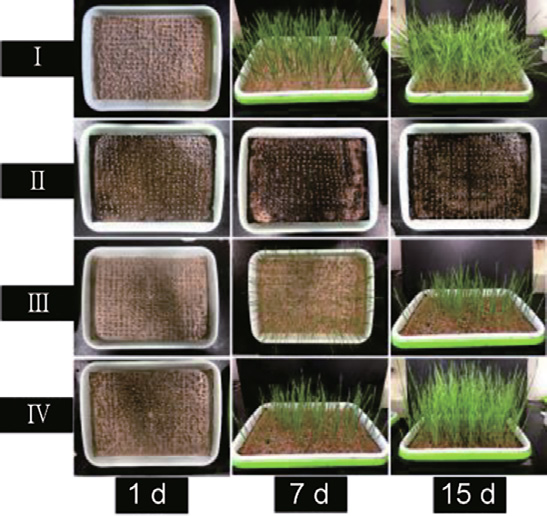
Fig. 11. Growth status of wheat seedlings cultivated in various drilling fluid systems for 1, 7, and 15 d.
《Fig. 12》
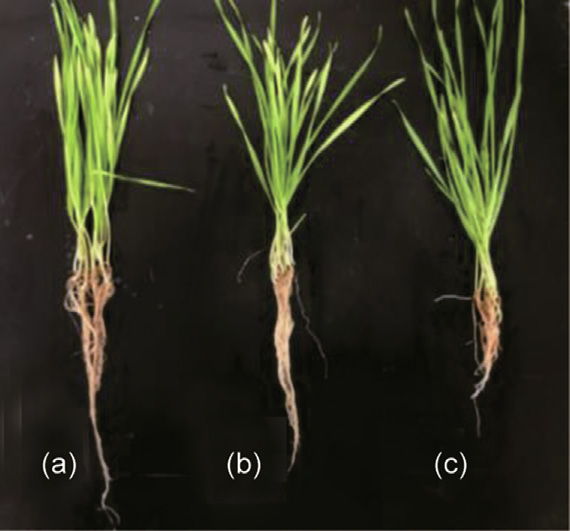
Fig. 12. Growth status of wheat roots in a range of drilling base fluids: (a) No. I; (b) No. IV; (c) No. III.
In-depth ecological tests were performed on wheat that had been grown for 15 d, and the results are listed in Table 13. The growth of wheat cultivated with No. I blank sample and No. III drilling fluid differed, the metal contents were generally similar, and neither contained aflatoxin. Chlorophyll content of the wheat cultivated in the No. III drilling fluid was slightly lower. In general, the wheat cultivated in the investigated drilling fluids did not contain toxic or harmful components and met the requirements for green food. The proposed drilling fluid technology thus achieved an acceptable environmental performance for waste drilling fluid and served as a link in the nutritional and ecological circulatory systems of natural plants. For this reason, the drilling fluid can be upgraded from an environmentally protective class of drilling fluid to an ecologically friendly class of drilling fluid.
《Table 13》
Table 13 Test results for wheat components.

N.D.: not detected.
《4. Field applications》
4. Field applications
The novel WBDF technology developed in this study was applied to more than 1000 unconventional complex oil and gas field wells, including the Zhaotong shale gas, Bohai Bay shale oil, Sulige gas, Songliao Basin tight gas, Junggar Basin dense oil, and Shanxi coalbed methane fields, as well as in similar well fields outside of China. Compared with OBDFs and other high-performance WBDF technologies used in the same area, the proposed drilling fluid system offers outstanding advantages in terms of inhibition, borehole stability, fluid loss reduction, rheology, lubricity, and environmental protection, and noticeably increased oil and gas well production. The average borehole collapse rate was reduced by 82.6%, the loss rate was reduced by 80.6%, the complex situation of blockage and sticking of the tool was reduced by 80.7%, the ROP was increased by 32.8%, and the production was increased by more than a factor of 1.5. Moreover, the technology was adopted by Schlumberger (USA) and applied in the contracted 100% tight gas horizontal wells in Yan’an Baota, Zichang County, and Ansay. The average ROP was increased by over 30.1%, the comprehensive drilling fluid costs were reduced by 42.3%, and production increased by a factor of more than 1.6. The field tests and applications indicate that the proposed technique achieves the integrated objectives of ensuring borehole wall stability, improving lubrication and plugging, loss prevention and curing, formation and environmental protection; thus, in terms of appropriate scaling, efficiency, and environmental protection, is an effective key and core technology for developing unconventional and other complex oil and gas resources in China. Its applications in shale gas, tight gas, and coalbed methane wells are described in the following sections.
《4.1. Improving the quality of shale gas reservoir boreholes while drilling》
4.1. Improving the quality of shale gas reservoir boreholes while drilling
The Zhaotong shale gas formation is complicated and determines how its horizontal sections can be drilled. The borehole wall rock suffers from serious hydration and swelling, peeling off, and blocking and sticking of the drilling tool. OBDFs have been applied in previous attempts to avoid or alleviate these problems and to improve the borehole wall quality, but this has resulted in environmental damage and increased drilling costs. Therefore, in 2018, other internationally-used high-performance WBDFs were applied in the YS118H4-6, YS129H, and Yang 102-H36-1 wells, but they caused borehole collapse, serious and frequent pipe sticking, and high holding pressures. This approach also failed to allow continuous drilling and OBDFs needed to substitute complete drillings, thereby leading to uncertain cementation quality.
To overcome this problem, the WBDF developed in this study was tested in the YS145, Yang102-H36-3, and Yang102-H36-2 wells in 2019. These wells have complex formation conditions and a higher risk of borehole collapse, pipe sticking, and loss. The results indicate that the improvement of the borehole quality during drilling provided good stability and lubrication performance, low torque, and eliminated the risks of high holding pressure and borehole collapse. Its downhole safety attributes are therefore considered good, and the cementation quality is high. This approach has gradually been promoted and applied in shale gas wells throughout China and has been extended to shale oil wells, thus transforming the original OBDFs with high costs and high environmental pollution risks into WBDFs. Fig. 13 compares the postdrilling condition of the drilling tools and bits with the use of the developed WBDF with those of other high-performance WBDFs.
《Fig. 13》

Fig. 13. Effect of applied wells. (a, b): Yang 102-H36-3 drilling pipe and bit treated with the developed WBDF are clean, whereas, in (c) and (d), serious bit balling is observed in an adjacent comparison well on the same platform that was treated with other WBDFs.
《4.2. Notable torque reduction ensures safer drilling》
4.2. Notable torque reduction ensures safer drilling
Bozhong19-6 is a large-scale high-temperature gas field in Bohai Bay, China, with a gas production area of 1011 m2 . This gas field occurs in a complex formation, and the bottom hole temperature reaches up to 192 °C. However, the torque rapidly increases, and during the drilling process of the long-section horizontal well, the drilling tool is exposed to high risks of cracking, thereby seriously threatening downhole safety. Moreover, the application of a series of engineering measures yielded no apparent improvements, and normal drilling remained difficult. The proposed bonded lubricant was therefore selected from nearly 100 types of advanced lubrication additives and gradually added to the drilling fluid system to reach a weight percentage of 1.5%. It decreased the average resulting torque by more than 56.3% and there were no corresponding adverse effects on the rheology of the drilling fluid and filtration wall building capacity, which ensured normal drilling pressure and revolution speed. Furthermore, no complicated underground scenarios or accidents have since been reported. Therefore, this demonstrates the outstanding contribution of the developed WBDF to the construction and production of the largescale Bozhong 19–6 gas field, which can be used by Beijing for more than 50 years.
《4.3. Protected coalbed methane reservoir and notably increased production of coalbed methane wells》
4.3. Protected coalbed methane reservoir and notably increased production of coalbed methane wells
Prior to 2015, nearly 100 wells were drilled in the coalbed methane fields of the Zhengzhuang and Fanzhuang blocks in the Qinshui Basin, Shanxi Province, using other coalbed methane drilling fluid technologies. However, owing to severe reservoir damage, the daily production of each well was limited to approximately 2000–3000 m3 , which was lower than the financial break-even point, resulting in negative economic benefits. Accordingly, investors had planned to terminate the development of these two blocks.
However, after adopting the proposed WBDF in 2016, the daily output of all wells reached 8000–9800 m3 , under the condition of screen pipe completion. This improvement considerably boosted margins past their break-even point, enabling the revitalization of the coalbed methane resources in the Zhengzhuang and Fanzhuang blocks, and leading to the promotion and application of the developed technology throughout the entire Qinshui Basin. By 2020, the largest coalbed methane field in all of China was developed in the Qinshui Basin, with an annual output of more than 6 × 109 m3 , which can satisfy the daily needs of more than 60 million people. This technology has occupied more than 80% of the market share of coalbed methane wells, which face high difficulties in China.
《5. Conclusions and suggestions》
5. Conclusions and suggestions
(1) Unconventional oil and gas resources are vital reserves, and their efficient exploration and development are of great significance for improving the supply rates of oil and gas in China and safeguarding national energy security. However, serious technical problems are often encountered during the drilling process, including borehole collapse, loss, and high friction, which cannot be resolved using existing drilling fluid theories, methods, and technologies. These issues affect the well-completion ratio and pose a common and critical challenge, particularly because of subsequent damage to unconventional and other types of complex oil and gas reservoirs.
(2) The international frontier external method only improved the inhibition and lubricity of the drilling fluid. That approach has been expanded here, to include a combination of internal and external factors for the improvement of the borehole quality during drilling. Bionics were introduced into the chemical material synthesis process of petroleum engineering to develop a novel drilling completion technology for the safe, efficient, and environmentally friendly development of unconventional oil and gas resources during drilling; to both improve the drilling borehole walls and protect the reservoir. This approach enhances the cohesion and cementation force between rock particles in the borehole wall, transforms capillary suction into resistance, converts high friction into ultra-low friction, and upgrades the environmentally protective class of drilling fluid to an ecologically friendly class of drilling fluid. This method integrates the advantages of OBDFs into a WBDF, which had previously posed a decades-long challenge, and opens up a novel research direction for subsequent research and the development of safe, efficient, economic, betterperforming, and environmentally friendly WBDFs.
(3) The successful on-site validation and application of over 1000 highly difficult unconventional oil and gas wells in China indicate that the proposed drilling fluid technology noticeably reduces the occurrence of complex situations (e.g., borehole collapse, loss, and high friction), elevates the well completion ratio, and protects the reservoirs. The approach presented herein is therefore an effective core technology for developing unconventional oil and gas resources, with advantageous scaling, efficiency, and environmental protection attributes.
(4) In the future, unconventional and other complex oil and gas resources in China and worldwide will encounter severe challenges because of increasingly deep burial depths, more complex formation conditions, and higher temperatures. The drilling fluids required will therefore also inevitably face unprecedented challenges, and existing technologies may not sufficiently satisfy the requirements of complex formation and surface conditions. Natural structures and processes offer valuable insights for novel technological development and provide an inexhaustible source of ideas for human inventions and creative innovation. Therefore, we suggest that learning from nature should be encouraged and strengthened, and may ultimately accelerate the technological revolution of the petroleum industry, as well as drilling fluid technology.
《Acknowledgments 》
Acknowledgments
This work was supported by the National Natural Science Foundation of China Youth Science Fund Project (52004297) and China Postdoctoral Innovative Talent Support Program (BX20200384).
《Compliance with ethics guidelines 》
Compliance with ethics guidelines
Guancheng Jiang, Jinsheng Sun, Yinbo He, Kaixiao Cui, Tengfei Dong, Lili Yang, Xukun Yang, and Xingxing Wang declare that they have no conflict of interest or financial conflicts to disclose.

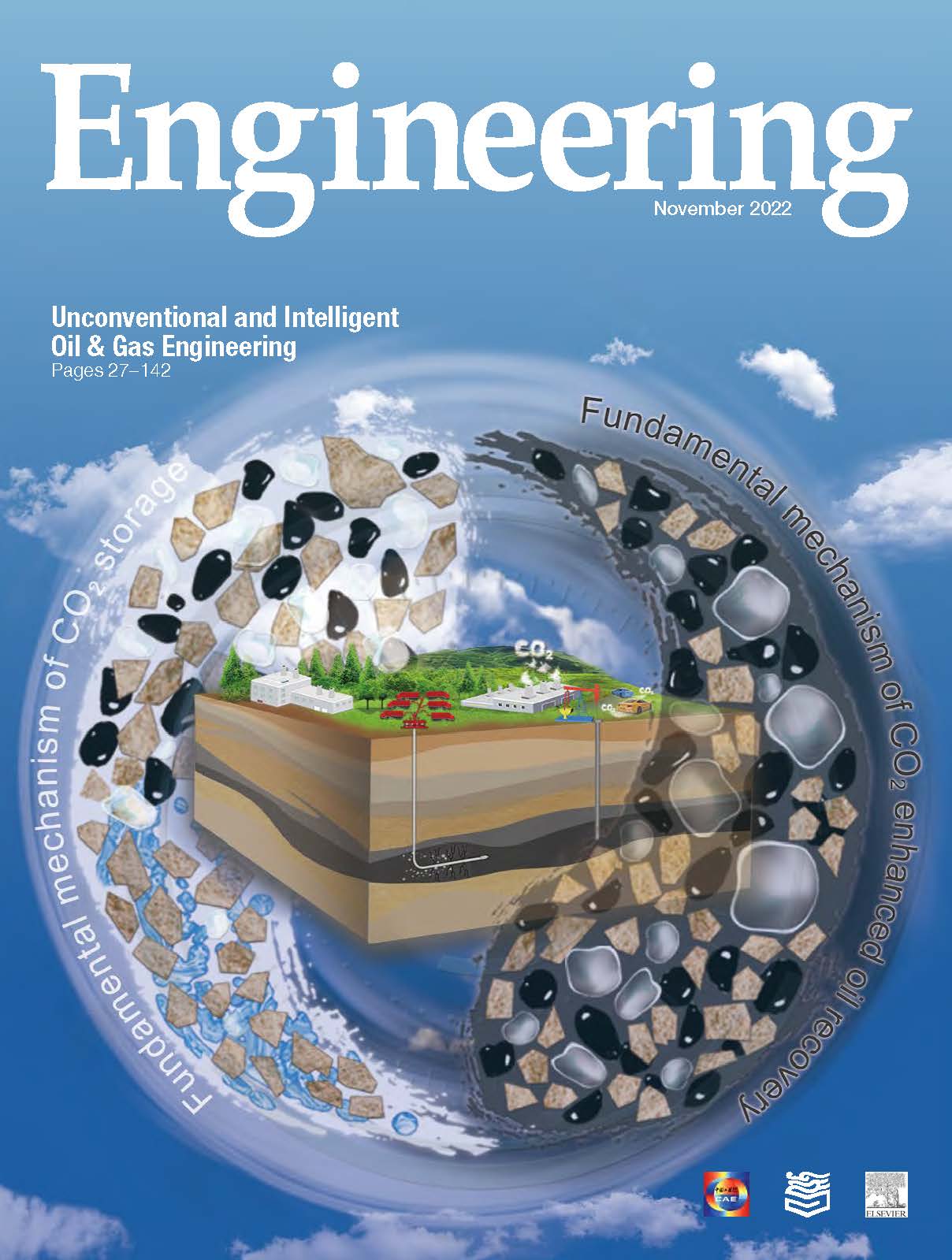












 京公网安备 11010502051620号
京公网安备 11010502051620号




